KENT MCALLISTER and HICKMAN BROWN, Wood Group Mustang
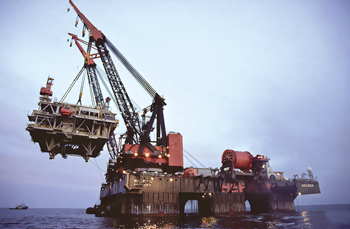 |
| A single-lift topsides design saves time, reduces safety exposure and is less expensive to build than the conventional modular approach. |
|
The design of any offshore structure is no easy task. There are numerous influential drivers that can dictate its layout and payload. New concepts, unique materials of construction and deepwater experience have led to continued discussion of best practices in topsides design. An overriding factor in any deepwater project, however, is cost. And, since the weight of both the structure and the topsides production facility directly impacts cost, it must be a top priority for design considerations. Our experience has shown that a topsides installed cost ranges from $35,000–50,000/ton. By reducing the weight of a 20,000-ton topsides by 15%, it is possible to slash capital costs of the project by $100-150 million—not a savings to be overlooked.
This article will address the concept of “lightweight” and, based on our experience, enumerate numerous possibilities and contributions from multiple disciplines for designing a topsides facility with less weight, but comparable operational capabilities.
WHAT IS “LIGHTWEIGHT”
The term “lightweight,” as it refers to topsides production facilities, is not new. In this context, it is usually used to describe a structure that weighs substantially less than a conventional facility, while performing the same basic function. However, there is not a single definition or solution for all lightweight projects. Recently, the term has been discussed even more by operators and engineers because of the increasingly positive operating history of weight and gravity sensitive deepwater floating structures, including spars, TLPs, and semi-submersibles.
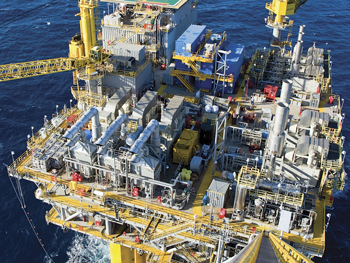 |
| Fig. 1. The challenge of a lightweight design is to find a way to incorporate all of the topsides requirements, without compromising safety and operability, while maintaining the weight below the lifting capacity of available lifting devices, whether onshore heavy lift devices or floating derrick barges. |
|
Lightweight is not synonymous with cheap, inferior or compromised, Fig. 1. Despite being lighter and more compact, there is still an emphasis on asset and personnel safety as with conventional topsides; an importance that can’t be compromised. Likewise, production capability, operability, flexibility, constructability and schedule are all considerations that must be understood and agreed upon by the operator and the design team during the project’s conceptual and front end phases.
The facility’s weight can be influenced by operator philosophies or preferences, regulatory requirements of the prevailing industry or governmental agencies in destination waters, drilling requirements, wet or dry tree installation and operational necessities. Despite all these constraints, experienced engineers can produce a lighter facility.
BENEFITS OF LIGHTWEIGHT TOPSIDES
The benefits of lightweight topsides are numerous. In addition to the cost savings that will accrue with less tonnage, there are many other advantages that can come from reduced weight. There will be a smaller substructure, regardless of whether the facility is fixed or floating. Using less steel on the hull or jacket means lower fabrication costs and, most likely, a shortened fabrication schedule. Mooring loads will be smaller, which can result in reduced mooring equipment costs.
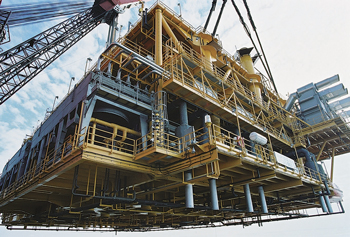 |
| Fig. 2. There is not a single definition or lightweight solution for all projects. The weight of the facility depends on many factors, including operating philosophy, personal or organizational preferences, regulatory requirements and operational requirements. |
|
Having a lighter weight lifted deck can also reduce the number of modules, Fig. 2. With a deck designed as a single module, either lifted quayside or onsite offshore, there is less redundancy in structural weight, better utilization of deck space for current operations and potentially more room for expansion. Fewer lifts will reduce schedule, cost and risk. Pre-commissioning, commissioning and startup windows should be shortened, further improving the project economics. A simple design results in less equipment, valving, piping and supports, as well as a more compact footprint. In addition to reducing weight, a less complicated design reduces the chances of human error in operating the facility.
DESIGN APPROACHES
There is no silver bullet to making the topsides light weight. Instead, it is the result of thousands of decisions made and challenges overcome by each discipline involved in the project. While some aspects of the topsides design will have more impact on weight savings, all disciplines make a significant contribution. The following, in logical order, are among the many items that must be considered or implemented at every stage and with every discipline.
Process design. While the design starts with the concept, its heart lies with the process design. Because fluid compositions and actual reservoir production rates are not fully known, the process needs to be streamlined and simplified. Creativity is needed to find ways to eliminate equipment redundancy. An example could involve the elimination of the wet oil tank since, typically, its size does not allow sufficient operational time to correct upsets. Other process considerations could include:
Identify the separation scheme and pressure cuts that meet a life-of-facility optimum need.
Use a high-pressure flare design without the use of atmospheric venting. This will reduce piping size and weight.
Utilize high-efficiency heating and cooling systems. In temperate climates, inhibited water can be used as a heat transfer fluid. Utilizing water, with its high thermal conductivity, will reduce the heat transfer requirements and the amount of fluid needing to be pumped. Since water is not flammable, operating at approximately 350°F presents less of a temperature hazard than other heat transfer fluids.
Use good judgment on line sizing. While attention needs to be paid to erosional velocity and noise issues, short-term operation above API RP 14E clean gas velocities can be advantageous to line sizing.
Carefully consider sparing requirements. While critical to ensure adequate uptime, a judicious sparing philosophy should be developed when establishing the design basis.
Develop creative solutions for reducing flow assurance chemical storage and equipment, a payload intensive requirement, can provide security and flexibility.
Fuel nozzle redesign reduces weight and energy usage.
The gas pipeline specification on a deepwater facility offshore Louisiana had limits on the lower heating value of the gas injected into the pipeline. Flash gas raised the value above the contractual limit. Attempting to reduce the dewpoint by condensing out heavier hydrocarbons elevated the Reid vapor pressure to a level exceeding the oil pipeline specification.
In lieu of instituting dewpoint suppression and condensate stabilization to meet the specification for each pipeline, the process designers worked closely with the vendor to design generator and compressor fuel nozzles to accept fuel gas with Wobbe numbers representative of the available enriched flash gas. The solution provided a simpler overall design with less equipment, lower energy usage and less weight.
Facility layout. The development of a lightweight topsides design must not compromise safety, especially for operating personnel. For example, there should be maximum separation between the process and living quarters. Ingenuity and involvement of participants such as package suppliers to modify their equipment designs can reduce the footprint to save weight. Other considerations include:
Create a logical process flow equipment layout so that the piping runs are minimized, effectively utilizing decks above and below and designed with safe access and egress in mind.
Utilize multi-level skids and stacked or vertical vessels to make efficient use of the space between decks and provide more space for other equipment. Porches can be used for lightweight process equipment rather than having all equipment placed on the main deck. Efficient use of dead space can avoid boxed-in areas that might hamper expansion.
Where acceptable, utilize free ventilation instead of enclosing areas. Our experience has demonstrated comparable safety levels, according to American Bureau of Shipping (ABS) standards, by allowing free ventilation to reduce gas buildups.
Where possible, locate heavy equipment, buildings and pedestal cranes near truss rows or girders so that it is placed on natural strong points.
Design perimeter walkways from lighter weight materials rather than fabricated from heavy steel.
Piping and mechanical. After defining the process and developing a logical layout, proper mechanical equipment selection and design are important in the evolution of the lightweight solution, as is simple, efficient pipe routing. Suggestions include:
Consider using skid packages only where necessary for fabrication efficiency. While an addition to schedule might develop, costs can be offset by reduced steel redundancy. Light, intricate equipment, such as utility packages, can be skidded without adding much weight and will reduce fabrication time. Larger and heavier equipment might be better suited for integration into the deck structure.
Use compact heat exchangers, such as plate and frame, to greatly reduce size and weight.
Utilize ASME Section VIII, Div. 2 vessels, where appropriate, and consider proprietary internals that can increase separation efficiency in a smaller envelope.
Make use of lightweight corrosion-resistant piping (FRP/CuNi) to reduce weight as an alternative to using heavy wall steel piping with a built-in corrosion allowance.
Use vertical pumps and smaller, stacked vessels instead of three-phase vessels. The smaller vessels can make better use of space and lower weight, because wall thickness can be reduced.
Use direct-drive pumps and compressors, where possible. Matching driver and driven equipment speeds can eliminate the need for gear boxes.
Use high-yield piping and specialty pressure-energized gaskets to increase piping design pressure and flange capacity without having to move to a higher class flange.
Utilize waste heat recovery and supplemental firing for process heating. This ‘green’ component can eliminate additional equipment. Where waste heat recovery cannot meet all design case heat duties, supplemental firing in the turbine exhaust provides flexibility and eliminates a separate, fired heater.
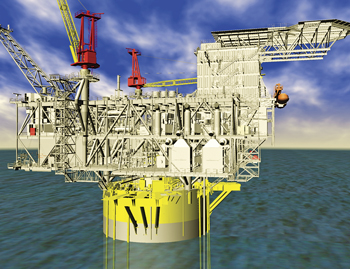 |
| Fig. 3. Once the weight budget is established, a rigorous system and procedure must be used to track not only the estimated and as-gauged weights of equipment, but all of the components that make up the deck structure and bulk weights. |
|
Structural. Typically 40-60% of the topsides dry weight is structural steel, Fig. 3. Opportunities for weight reduction by this discipline are critical to project success. Some suggestions include:
Design deck structures for dry weight and operating weight instead of for area loads. The approach ultimately provides a customized structure for fit-for-purpose topsides.
Design floor beams and girders specifically for the equipment they will support. Where available, use higher-yield steel for reduced weight.
Where appropriate, use deck plating to help gain stiffness without additional structural bracing. Lightweight decking, even 3/16-in. thinner, can provide a significant cost differential when calculated over the square footage of an average deck. FRP grating on access platforms can also provide additional weight savings, without impacting performance.
Plan early for the intended lift method. Design the deck and lifting arrangement with the intended lift device in mind, so that steel can be optimized and the lifting capacity can be maximized and most efficient.
STAGE-GATE PROCESS CRITICAL
Virtually all companies engaged in deepwater design projects rely on a stage gate-type process to develop alignment among all project participants. The influence of early front-end loading (FEL) stages of the process are the most substantial. From the development of a concept, which corresponds with the operator’s business goals, to the front-end engineering design (FEED) decisions that influence the scope, and on to project sanctioning, the decisions are critical. In the development of a lightweight topsides scheme, a realistic weight must be solidified early with reliable vendor data and prior project information. Lack of accurate weight estimation and rigorous control in those stages can dramatically, and adversely, affect structural and piping fabrication costs, hookup time and schedule delays. Conversely, a firm design basis, attentive oversight of design and freezing decisions at each stage can reduce weight, lower costs and limit risk.
DESIGN TEAM EXPERIENCE NECESSARY
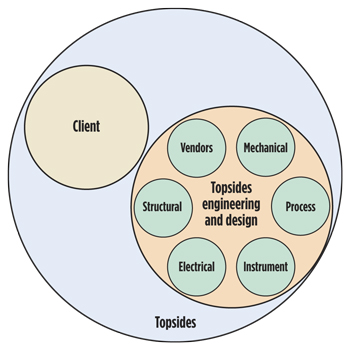 |
| Fig. 4. An experienced topsides team is indispensible for providing direction to the other project participants, in close coordination with the client and their requirements. |
|
The topsides team is a prime facilitator of all other participant ‘silos’—hull fabrication, subsea, loadout, lift and installation, Fig. 4. Choosing a design team experienced in lightweight topsides projects will utilize their ingenuity to provide direction for other project partners. Experienced lightweight topsides teams have accumulated an extensive database and metrics from previous projects, including detailed spreadsheet breakdowns of structural, equipment, buildings and bulk items. They have programs to calculate specific unit area weights, helpful as excellent bulk weight predictors. In certain areas, such as living quarters or MCC/switchgear buildings, manning levels and average unit weight can be extrapolated to quickly estimate the needed building weight. Similarly, databases from prior projects can assist in estimating pipeline isometric lengths and different types of piping materials required.
CONCLUSION
The development of lightweight topsides has resulted in many benefits. Operators have often been able to undertake larger projects than they might have done otherwise for the same or less cost. There are, however, many challenges. As with any topsides design, weights need to be estimates calculated early and correctly. Bulk weight items—piping, valves, supports, cable trays and safety equipment—can be big obstacles to weight reduction, if not a major focus. Constant monitoring during design and construction is imperative for maintaining lighter weight.
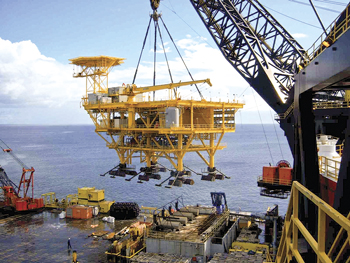 |
| Fig. 5. One of the key challenges to lightweight design is attitude. The norms of how the topsides will be designed must be questioned by everyone on the project team. This requires a willingness of the client to do things differently than he may have done in the past. |
|
The proper attitude is important, Fig. 5. Operators must be supportive of the lightweight design as a method unlike what they might have been used in the past. There must be a champion on the operator side and in the engineering firm to make the lightweight design work. The entire project team must be in sync in exploring new or different ways to meet the requirements of a safe, operable and maintainable facility, while selecting lighter approach. Design norms have to be challenged by all team members. Project success in lightweight topsides is usually the result of open mindedness and innovative thinking with a willingness to deviate from ‘the way we’ve always done it’. The accomplishment of a fit-for-purpose facility requires a design team that is able to draw upon lightweight topsides experience and a database of prior projects. 
|
The author
KENT MCALLISTER is vice president of global operations and workshare at Wood Group Mustang. Mr. McAllister has been with Wood Group Mustang for 16 years, working in various engineering and management roles on major and/or deepwater facilities projects including Tamar, Independence Hub, Magnolia and Horn Mountain. He holds a BS degree in chemical engineering from the University of Arkansas.
HICKMAN BROWN is offshore project manager with 36 years of experience in the oil and gas industry. At Wood Group Mustang, he has managed several major and/or deepwater projects including Tamar, Big Foot, Perdido and Independence Hub. Mr. Brown holds a BS degree in mechanical engineering from New Mexico State University and an MS degree in ocean engineering from the University of Rhode Island. |
|








